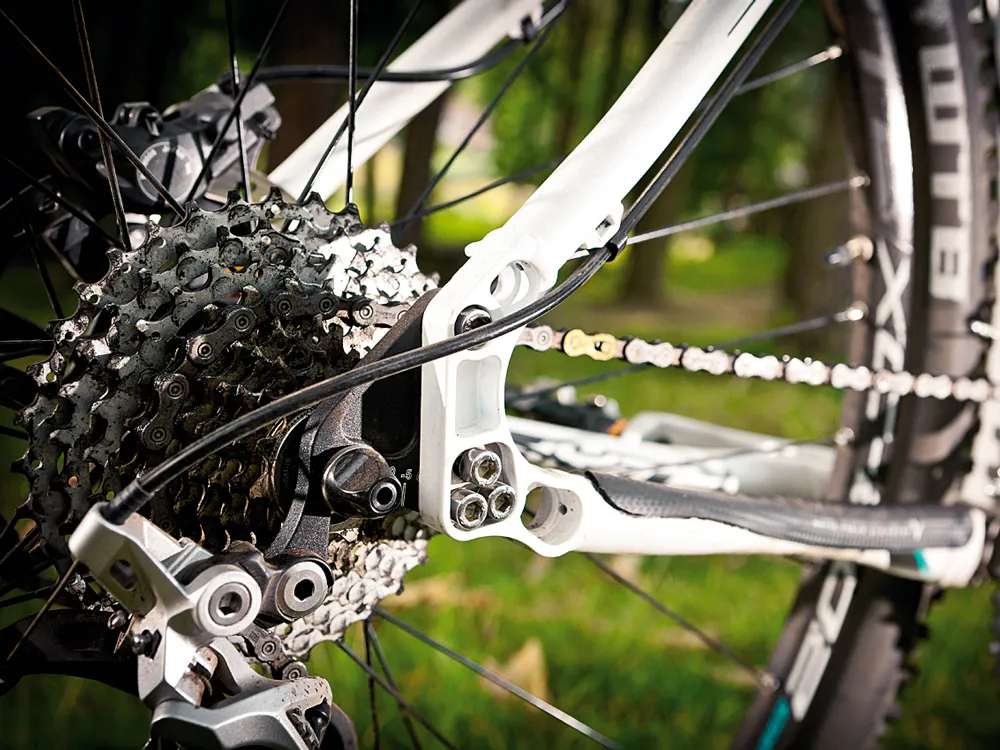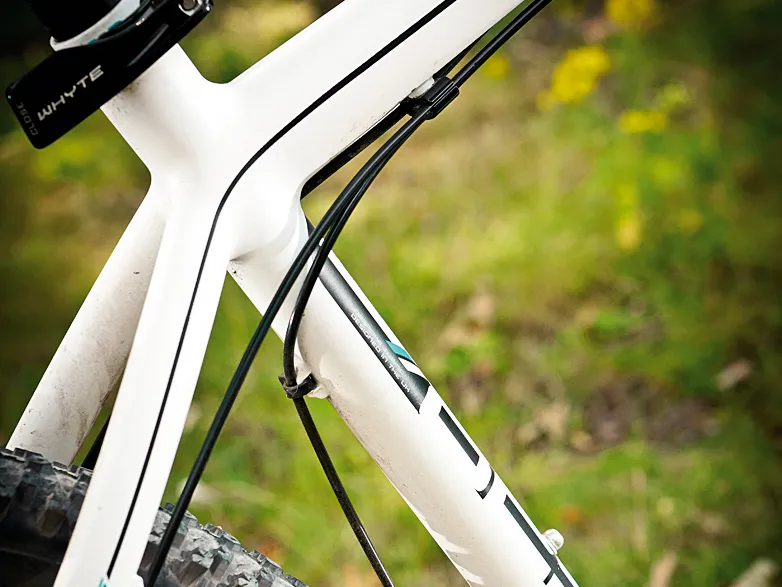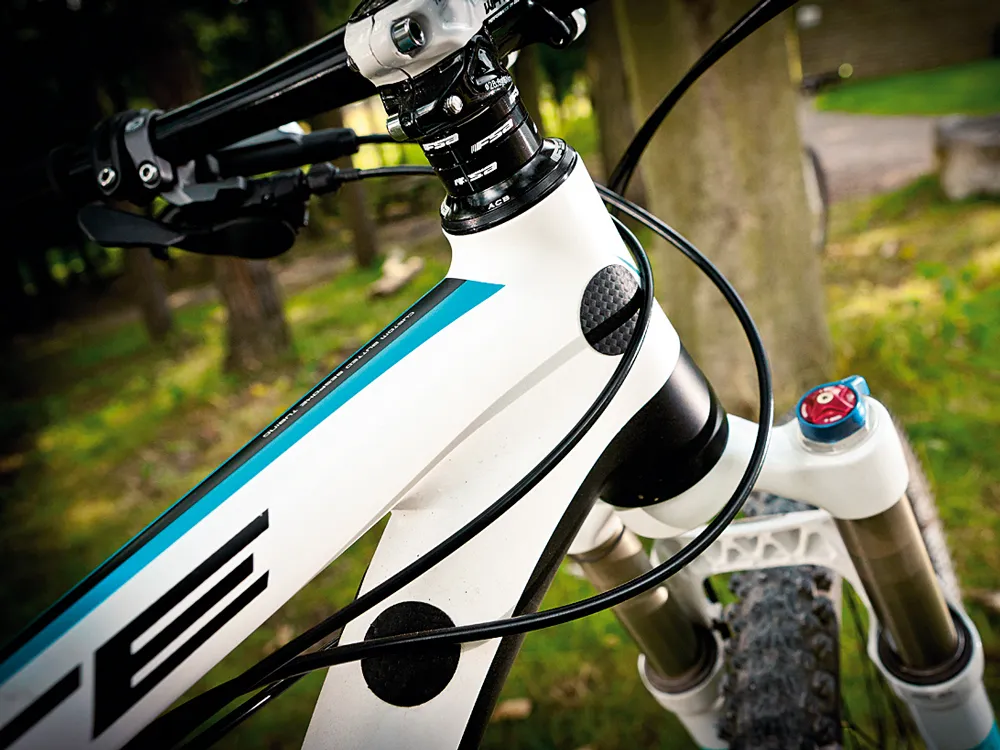Next year is undoubtedly the 29er bandwagon year for the UK, with bigger wheels present in pretty much every manufacturer’s line-up. Typically, British brand Whyte have produced their own trail-tangent approach with the all-new 829.
High weight means it needs some muscle to get it moving but in true hardcore hardtail fashion this is a bike that works best with gravity at its back, not in its face. Once you get it up to speed and start working the front end hard, the Whyte is a proper rough-smoothing, high-traction singletrack steamroller.
While it’ll boost confidence and control for novices and less aggressive riders, it really comes alive when you start to work with it rather than just sit on it. That makes it a great choice for those who want extra grip and control without the complexity of suspension.
Ride & handling: A fun and dynamic bike to ride
Grunting the bike out of corners or up climbs the combination of bigger wheel inertia and overall weight is noticeable, but then if you want a racer, get the carbon fibre Whyte 20-C. The curved seat tube puts the saddle right back towards the rear axle, so if you stay seated you have to adjust to a definite rearward pivot bias similar to a slacked out suspension bike. Once you’ve got used to the weight placement the short stem and tight back end let you haul the front end round typically 29er-defeating upward switchbacks with relative ease.
Each successive cleaned corner builds momentum and as soon as you get a chance to drive a few good pedal strokes through things really pick up. The big, supple WTB Bronson tyres will start to plane over small rocks and roots that can choke the momentum of smaller wheels and leave conventional hardtails rattling in their wake. This was particularly obvious on rootier sections where wear and tear had exposed bedrocks. The triple chainset and massive rear cog mean you’ll never be overgeared and the traction levels are fantastic on even the roughest surfaces.
Once you’re rolling or no longer fighting gravity, the 829 takes the ball and runs with it. The backward weight distribution means the front end pops up and over obstacles easily and despite the long front it manuals a lot easier than most 29ers, so ditches and drops are no problem. The long, low front and quality Fox F29 fork keep it lined up and predictable when lighter, racier bikes often start to lose the plot.
While the fork is taut and short rather than bump hungry when the hits get bigger, the Whyte feels more capable than most 100mm 29ers when things start getting bullish. It’s definitely better when ridden offensively rather than defensively. Pushing your weight over the front end in a full-on ‘bulldog’ stance stops the slightly distant front wheel’s understandable habit of sliding out when pushed too hard.

As soon as we drove our weight through the flat bars and down into the big front tyre contact patch we were blowing up big dust clouds round loamy berms as the WTB tyres ripped and roared their way in and out of traction. Short stem and tight back end make it easy to surf any back wheel drift with flair, making it a fun and dynamic bike to ride, rather than just a ‘roll around’ cross-country bike like most 29ers.
Whyte’s designers have done a great job making a fun trail rather than race hardtail with the benefits of smoother rolling 29er wheels. Having loved the more radical prototype bike, we wish they’d stuck with its even more capable hardcore ride. Especially when you’re paying a big weight penalty compared to similar but lighter bikes from their own range and other brands.
Frame: Hydroformed 6061 aluminium
The 829's 69-degree head angle is relatively slack to give a long front centre, while a generous top tube offsets the short-reach cockpit. The curved seat tube and super-wide chainstay yoke keep the back end as short as possible, with Whyte’s swinging dropout system letting you change effective chainstay length up to 20mm.
This not only lets you run a singlespeed setup without a tensioner, but also get the 829 back end within 8mm of the shortest Whyte 901 26in hardtail setting for fast summer handling and then open it out for more mud room in winter. Continuous outer cable routing and Crud Catcher mounts provide filthy weather protection. Whyte have only gone for bigger wheels on the larger 18.5in and 20in frame sizes in their hardtail range, keeping smaller wheels for smaller riders.
Equipment: Well specced
Whyte have moved to own-brand wheelsets for 2012. Freehub/bearing longevity is an unknown but initial build quality is good, with a 28-spoke front, 32 rear setup to shave weight. Fox’s 15QR axle F29 fork is a benchmark all-round control unit with travel limited to 100mm for a low front end. A full 3x10 version of the new Shimano XT transmission includes a wall climbing 36-tooth big sprocket at the back, while SLX brakes should provide ample stopping power. The big WTB Bronson tyres are good all-rounders too.
The 700mm flat bar and 70mm stem are Whyte’s own, as is the Fizik-esque seatpost highlight. Whyte tell us that the 1650g (3.63lb) frame weight is the same as the 26in-wheeled 19 alloy hardtail, but overall weight is definitely high, with a 1.1kg-plus (2.5lb) penalty over similar priced/travel 2011 29ers we’ve tested. With the lower specced but 1,080g (2.38lb, claimed) carbon frameset equipped Whyte 20-C only costing £100 more that’s the obvious choice for big-wheeled weight watchers. Wheel ambivalent bargain hunters should also check out the 26in-wheeled Whyte 810, which comes in at £400 cheaper despite a directly comparable spec level and a claimed 10.98kg (24.2lb) weight.




